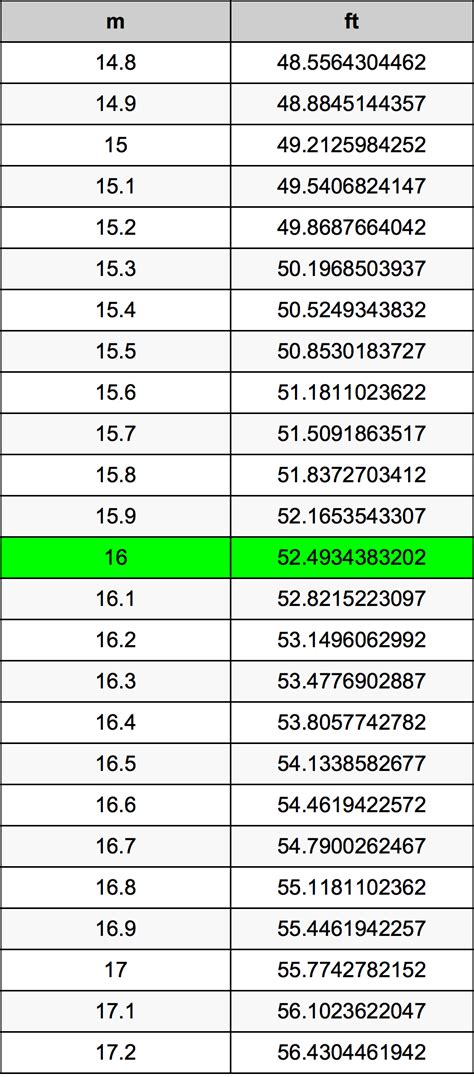Cuanto Es 16 Metros En Pies
Kalali
Apr 01, 2025 · 4 min read

Table of Contents
How Many Feet Are in 16 Meters? A Comprehensive Guide to Metric-Imperial Conversions
The question "cuánto es 16 metros en pies?" (how many feet are in 16 meters?) is a common one, particularly for those working with both metric and imperial units. This comprehensive guide will not only answer that question but also delve into the intricacies of metric-imperial conversions, providing you with the tools and knowledge to confidently tackle similar conversions in the future.
Understanding the Conversion Factor: Meters to Feet
The fundamental principle behind converting meters to feet lies in understanding the conversion factor. One meter is approximately equal to 3.28084 feet. This is a crucial constant that forms the basis of all our calculations. We'll use this factor to determine how many feet are in 16 meters and explore different methods for performing this conversion.
Calculating 16 Meters in Feet: The Simple Method
The most straightforward way to convert 16 meters to feet is to multiply the number of meters by the conversion factor:
16 meters * 3.28084 feet/meter ≈ 52.493 feet
Therefore, 16 meters is approximately equal to 52.493 feet. While this is a precise calculation, you might often round this to a more manageable number, depending on the context. For most practical purposes, rounding to 52.5 feet or even 52 feet would be perfectly acceptable.
Beyond the Basics: Exploring Different Conversion Techniques
While the direct multiplication method is efficient, understanding alternative approaches broadens your understanding of unit conversion and allows for more flexibility when dealing with different scenarios.
Method 2: Using Proportions
Proportions offer a clear visual representation of the conversion process. We can set up a proportion using the conversion factor:
1 meter / 3.28084 feet = 16 meters / x feet
Cross-multiplying, we get:
1 * x = 16 * 3.28084
Solving for x:
x ≈ 52.493 feet
This method reinforces the concept of proportionality and can be especially helpful when working with more complex conversions.
Method 3: Online Conversion Tools
Numerous online conversion tools are available that instantly convert meters to feet and vice versa. These tools are convenient for quick conversions, but understanding the underlying calculation is still crucial for problem-solving and avoiding errors.
Practical Applications: Where You Might Need This Conversion
Understanding meter-to-foot conversions is essential in various fields, including:
-
Construction and Engineering: Blueprint specifications might use either metric or imperial units, requiring seamless conversions between them. Imagine converting the dimensions of a room from meters to feet to ensure accurate material ordering.
-
Real Estate: Property measurements are often provided in both systems. Converting between meters and feet is vital for accurate property comparisons and land area calculations.
-
Manufacturing and Industry: Many manufacturing processes involve components with dimensions specified in different unit systems. Accurate conversions are essential for seamless integration and error prevention.
-
Sports and Athletics: Track and field events often use both metric and imperial units. Converting distances between systems ensures accurate record-keeping and comparison of athletic performances.
-
Travel and Navigation: Maps and navigational tools may utilize different unit systems, necessitating conversions for accurate distance calculations and route planning.
Common Mistakes to Avoid When Converting Units
While the process seems straightforward, several common mistakes can lead to inaccurate results:
-
Incorrect Conversion Factor: Using an incorrect conversion factor is the most frequent error. Always double-check that you are using the accurate value (approximately 3.28084 feet per meter).
-
Unit Mismatches: Ensuring consistent units throughout the calculation is crucial. Mixing meters and centimeters, for instance, will lead to errors.
-
Rounding Errors: While rounding is acceptable for practical purposes, excessively early rounding can introduce significant errors, especially in complex calculations.
-
Ignoring Significant Figures: In scientific or engineering contexts, paying close attention to significant figures is vital to maintain the accuracy of your results.
Expanding Your Knowledge: Converting Other Metric Units
The principles of unit conversion extend beyond meters and feet. Familiarizing yourself with the conversion factors for other common units, such as centimeters to inches, kilometers to miles, and liters to gallons, will enhance your problem-solving abilities in various contexts. This understanding proves invaluable in international collaborations and situations involving multiple unit systems.
Conclusion: Mastering Meter-to-Foot Conversions
Mastering the conversion between meters and feet is a valuable skill that extends beyond simple arithmetic. It represents a crucial understanding of unit systems and their practical applications in diverse fields. By understanding the underlying principles, employing various calculation methods, and avoiding common mistakes, you can confidently navigate the world of metric-imperial conversions and tackle any similar challenges with ease and precision. Remember that 16 meters is approximately 52.493 feet, a conversion you can now confidently perform and apply in your daily life or professional work. The ability to swiftly and accurately convert between unit systems is a testament to your problem-solving skills and attention to detail.
Latest Posts
Latest Posts
-
What Is The Average Atomic Mass Of Titanium
Apr 02, 2025
-
How Much 160 Cm In Feet
Apr 02, 2025
-
List Four Common Characteristics Of All Animals
Apr 02, 2025
-
How Long Can A Lizard Live For
Apr 02, 2025
-
81 Centimeters Is How Many Inches
Apr 02, 2025
Related Post
Thank you for visiting our website which covers about Cuanto Es 16 Metros En Pies . We hope the information provided has been useful to you. Feel free to contact us if you have any questions or need further assistance. See you next time and don't miss to bookmark.
